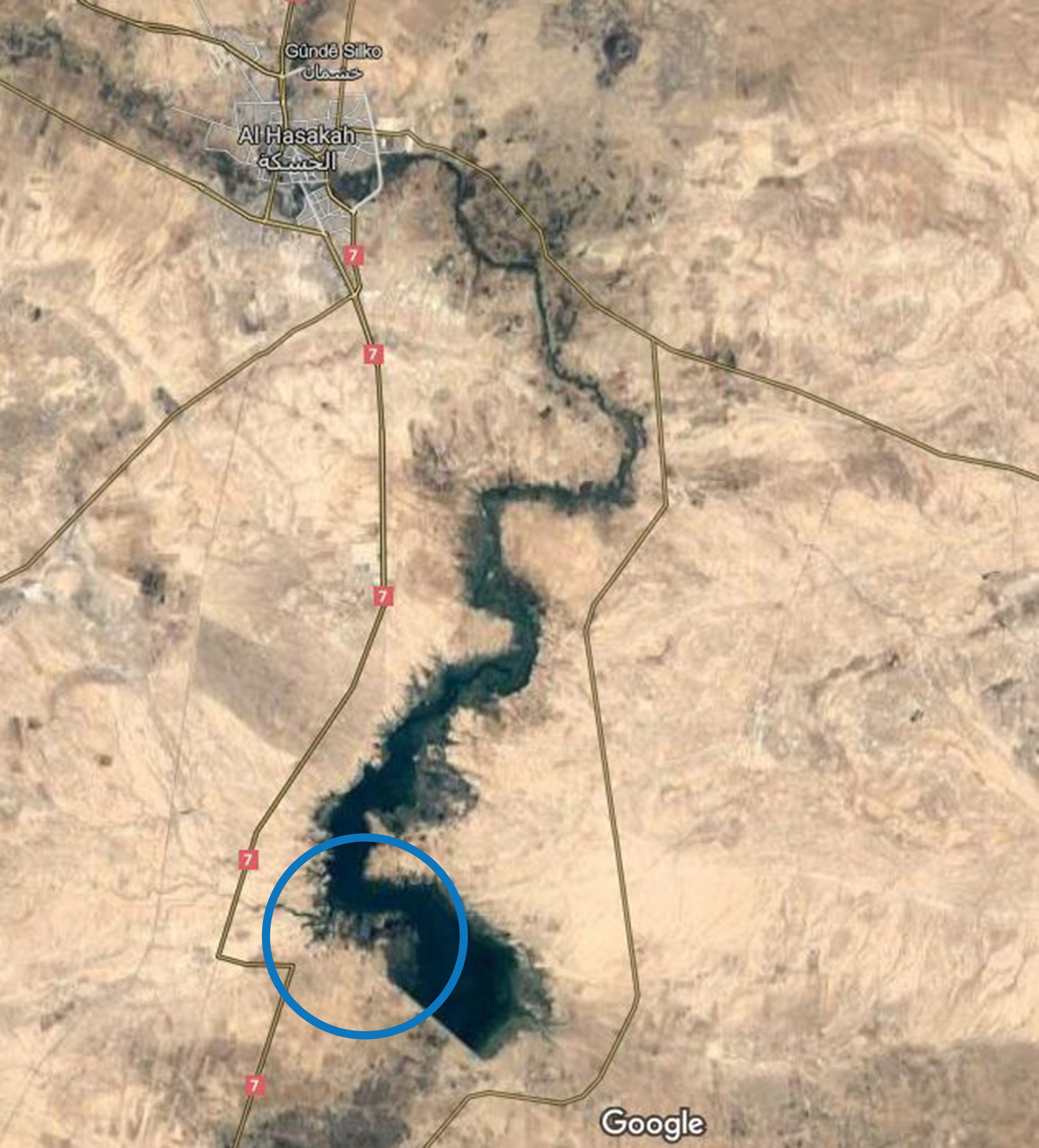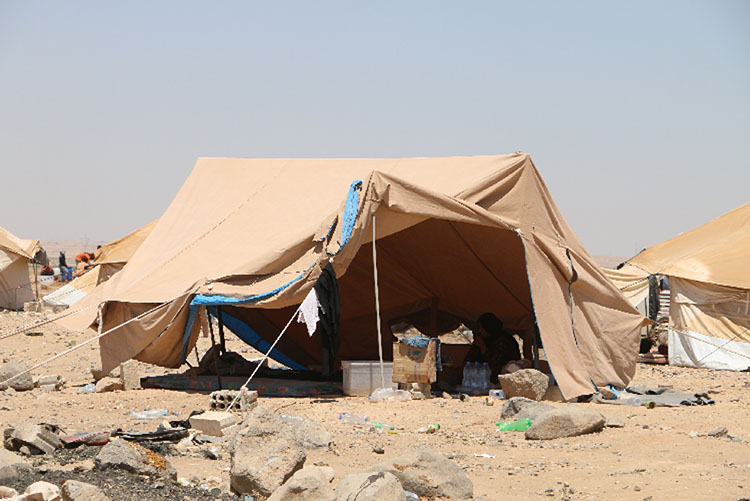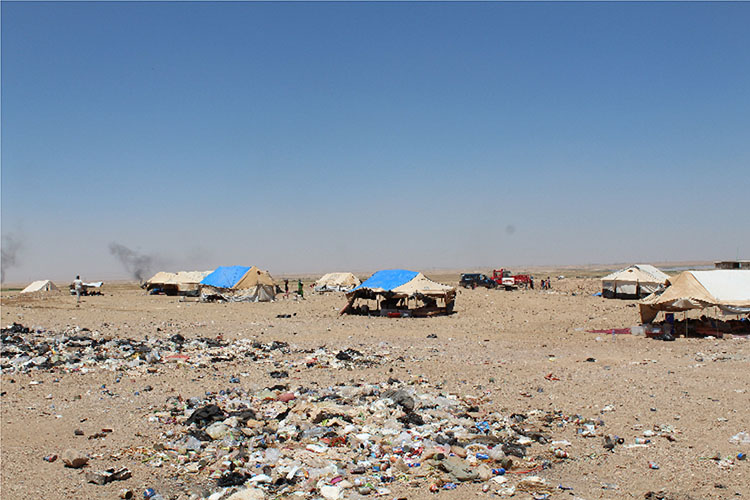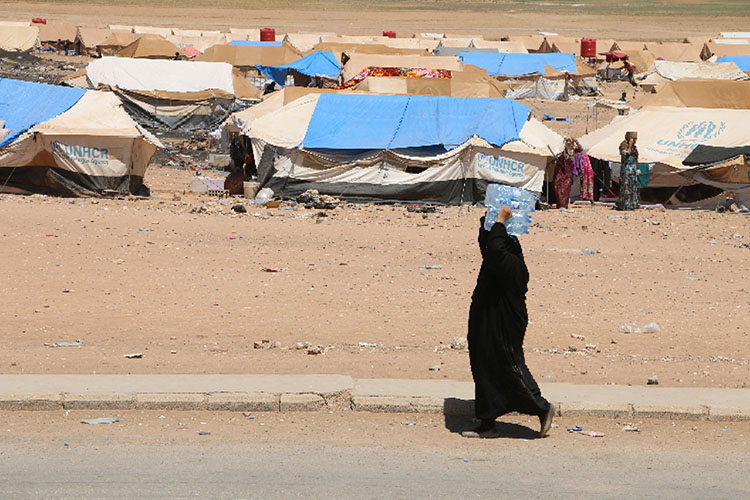Preface: Up to 4,000 internally displaced persons[1], according to Syrians for Truth and Justice-STJ reporter, still suffer from difficult humanitarian conditions within "al-Shadadi camp" south of al-Hasakeh as a result of shortages of food, drinking water and poor medical conditions in the camp, in conjunction with the increase of displacement from the north-eastern regions of Syria, particularly areas of Deir az-Zor given it is witnessing intense fighting for more than two years between forces of the Syrian government against the Islamic State Organization, ISIS, in order to capture it and take it out of the hands of the organization. Besides later, in September 2019, the battles launched following the "Operation Cizire Storm- also called Island Storm" to capture the eastern countryside of Deir az-Zor declared by the "Deir az-Zor Military Council”, under the banner of the Syrian Democratic Forces (SDF) backed by the Global Coalition Against Daesh.
Al-Shadadi camp, also known as al-Arisha camp, is 35km south of al-Hasakeh and 20km south of al-Shadadi town. On June 14, 2017, the Autonomous Administration opened it hastily because of the increase number of the displaced and after promises of support made by the Office of the United Nations High Commissioner for Human Rights/OHCHR, according to the camp administration. The camp administration also said that the number of the displaced in al-Shadadi camp reached about 10,000 displaced in the previous months of the year 2017, but since the beginning of September 6, 2017, approximately 5,000 displaced has left the camp for Damascus either for cure or to get a job opportunity, STJ reporter confirmed.

A sattelite image shows the approximate location of al-Shadadi camp for the displaced south of al-Hasakeh.
During his field visit to al-Shadadi camp, mid- August 2017, STJ reporter managed to interview numerous of people who described the difficult living conditions in the camp.
First: the First Moments of Displacement
With the beginning of June 2017, the Syrian regular army intensified the bombardment on ISIS-held territories in Deir az-Zor province thus led many civilians to flee from their areas to safer ones; one of them was a young woman identified as Abeer al-Hasan who fled on June 16, 2017, with her family from as-Salhiya area located in the province and succeeded to reach the administrative borders in al-Hasakeh on June19, 2017. Three days later, she along with her family headed towards al-Shadadi camp, she testified to STJ that the displacement journey lasted three consecutive days mostly on foot. In this regard, she says:
“We displaced from our region and walked on foot for two continuous days until we met one of the smugglers, who drove us on a three-wheeled motorcycle for a distance of 8 km, then we reached a road and he asked us to remain calm and silent, like a stone, so that ISIS do not reveal our place. We completed our journey on foot, and given my uncle could not keep walking since he was old, we rented a donkey from a passerby, a dealer with the smugglers, with 16,000 Syrian pounds so we could get him to safety with the least possible losses. Even the shoes I was wearing tore through the road and were no longer fit to complete with because of the ruggedness of the road that we had walked from the moment we left our region until the moment we reached al-Hasakeh border.”
In another testimony, Salman al-Mohammed, a resident of al-Husseiniyah area in Deir az-Zor, said that he and his family had also displaced to al-Shadadi camp on June 5, 2017, hoping to escape the inferno of ISIS, as he expressed, and reach safety. Three days after walking, they succeeded in reaching the camp using one of the smugglers. Salman said:
“We got out of our regions taking into consideration, according to smugglers, that the walking distance to get out of ISIS-held areas is only 700 m, the reason that encouraged me to escape from ISIS areas with several women from the family whom were old. Unfortunately, we walked a distance of 10 km non-stop; we only stop a little to take some air. In addition to the kilometers we had already walked, I didn't know exactly how many kilometers we walked in the other distance, but all what I know is that we walked over an hour and a half until we got to al-Hasakeh border where we got in a car that drove us to the camp."

Image shows a tent in al-Shadadi camp for the displaced south of al-Hasakeh, taken during the field trip in mid-August 2017.
Photo Credit: STJ
Second: Causes of Displacement and the Hardship of the Road
Abeer al-Hussein added that the deteriorating security situation and the inability of her family to earn a living in Deir az-Zor are the reasons that led them to decide to migrate, particularly with the great fear of ISIS practices as well as the Syrian warplanes bombardment that never escaped the skies of their city. Abeer only said:
“We fled As a result of the barbaric bombardment of planes; I took my daughter out from under the debris 6 times in less than two weeks! So what should I do, should I stay there until I see my daughter loses her life in the seventh time?”
Salman al-Mohammad also spoke about the reasons for their displacement to al-Shadadi camp with his family, noting that ISIS was tightening its grip on the people of his city in an indescribable way to the extent that they were storming homes under any pretext. In this regard, he continued:
“Recently, soldiers of the organization raided the houses, under different pretexts. For example, if they saw a dog in front of the door of a house, they were running into, beating and swearing the owners of the house on the pretext that they did not kill the dog. Moreover, when they sighted our women without "the dress prescribed by them”, even if these women were inside the house, they were luring the young men to prisons in order to severely beat and torture them.”
The displaced Mohammed Kabran al-Khalaf, a father of two children with special needs, escaped from the al-Asharra area in Deir az-Zor, is one of the people whom were interviewed during the field visit and he described his sufferings in the camp, saying:
"I displaced to the camp very hopeful to treat my disabled children but once I arrived I was surprised by the situation here, my both children need a physiotherapist and a neurologist. However, this was not available here. Both my children are incapacitated and cannot walk to the bathroom, notably with no bathrooms available in the camp."
To view the full testimony of the displaced Mohammed Kabran al-Khalaf (video tape) please click here.
Third: Many Sufferings within the Camp:
Several difficulties face the displaced persons in al-Shadadi camp, beginning when they once arrive at the camp and ending with a lack of the lowest elements of living. Abeer al-Hussein confirmed this when she reported to STJ that the camp administration had taken all her identity documents as soon as she arrived there, like an ID and the statement of her marital status, now, leaving the camp is forbidden unless there is a mediation of a guarantor from the city of al-Hasakeh. She said:
"At first I tried to leave with my family to Damascus, but the camp administration told me I that I was unable to do so unless I had a sponsor to enter al-Hasakeh; indeed we accepted that and we stayed here. It has been more than a month and I have only received one aid basket for my family that consists of six people. Moreover, some stuff of the basket was rotten and was not even suitable for feeding animals, besides there were materials inside the basket that could only be eaten after cooking. Since we have no stove in the camp to cook on, many of the people in the camp sell those materials to brokers inside the camp, so they get some money to buy bread because every day each person in the camp has only two loaves of bread, which are not enough to fill the hunger. As a result, my family and I initiated, a short time ago, to apply for a return to Deir az-Zor, despite the control of ISIS, as we had enough here."
In a crosschecked certificate, Salman al-Mohammad repeated what Abeer had already said about taking identity documents of most of the displaced as soon as they arrived at al-Shadadi camp. He also referred to the poor medical condition of the majority of the displaced persons in the camp, citing the case of his mother who required undergoing a surgery to open her chest. However, it was unable to do the surgery inside the camp given the lack of medical potential available for such operations, therefore Salman was forced to review the camp administration and register her name among thousands of names until he is authorized to leave the camp to perform the operation for his mother. Nevertheless, most of his attempts did not work, according to his expression. He continued saying:
“Look at the garbage and trash here and there, it is a place difficult for even the animals to live in. As for the camp administration, it is like talking to a brick wall. With the beginning of August 2017, the department filled some of the reservoirs in the camp with water, but it smelled and tasted the diesel material, and we could not ever drink it. I confess frankly that I am currently ready to go back and die in my city rather than to stay here for my family and me. Imagine we are receiving one aid basket in one month by the organizations working in the camp, and if we want to buy anything from camp stalls, we are unable to buy it given their prices are very soared. Even the bathrooms are not available in the camp, and we, the men, are forced to go far away from the camp to go to toilet, but the women have no choice but to wait the sunset in order to cover themselves”.

Image shows some of the garbage and trash discarded alongside with tents of the displaced in al-Shadadi camp south of al-Hasakeh, taken in mid-August 2017.
Photo Credit: STJ

Image shows a woman in the camp while transporting water to her tent, taken in mid-August 2017.
Photo Credit: STJ
STJ field researcher filmed a videotape, showing some of the deterioration of services in the camp due to the spread of garbage and dirt among the displaced tents, he also filmed another videotape showing two girls from the camp while filling water from hosepipes of the ground reservoirs inside al-Shadadi Camp
STJ reporter said there were several deaths recorded in al-Shadadi camp during August 2017. For example, a young girl died because of dehydration due to severe heat in the camp, also an elderly woman died as a result of a severe heat, in addition to the death of a girl after committing suicide, but none of those names were identified. STJ reporter confirmed that there were several humanitarian organizations working in al-Shadadi, some of which secure food parcels once a month, and others always distribute food parcels. Perhaps the most prominently is the Office of the United Nations High Commissioner for Refugees (UNHCR), the Syrian Arab Red Crescent (SARC), as well as the Kurdish Red Crescent (Heyva Sor), and the United Nations Children's Fund (UNICEF).
[1] The figure, the latest obtained by STJ, was updated on September 11, 2017.

